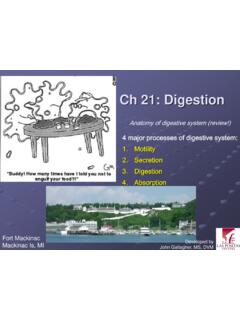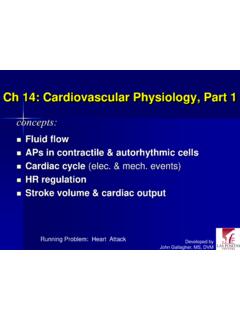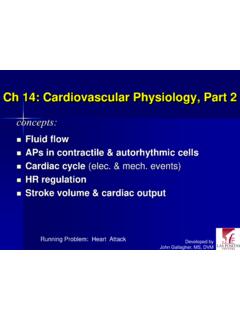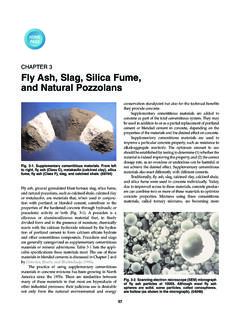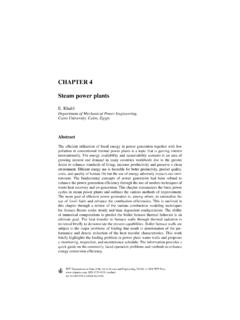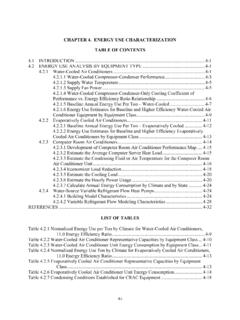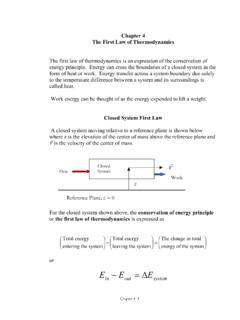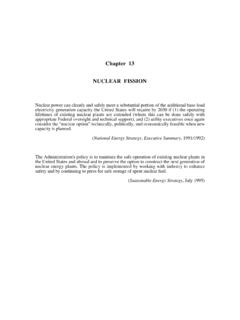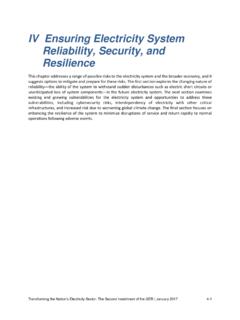Transcription of Chapter 3: Review of Basic Vacuum Calculations
1 Las Positas College Vacuum Technology 60A & 60B Page 33 Rights Reserved, Biltoft, Benapfl, and Swain Fall 2002 Chapter 3: Review of Basic Vacuum Calculations Before we go any further, some time should be spent on some of the vocabulary specific to Vacuum technology. Vacuum : from a practical sense, Vacuum may be defined as the condition of a gas under less than atmospheric pressure. Table : Vacuum ranges Vacuum Description Range Low Vacuum 25 to 760 Torr Medium Vacuum 10-3 to 25 Torr High Vacuum 10-6 to 10-3 Torr Very high Vacuum 10-9 to 10-6 Torr Ultrahigh Vacuum 10-12 to 10-9 Torr Extreme Ultrahigh Vacuum below 10-12 Torr Vacuum technology is based upon the creation of an environment in which a process (thin film deposition, electron beam welding, etc.)
2 Can be carried out. This normally implies that one remove air from a system to some acceptable sub atmospheric pressure by the use of some type of Vacuum pumping equipment. Atmosphere: The blanket of gases that surrounds the surface of the earth and extends outward to a distance of about 25 miles is referred to as "air" or "the atmosphere". This mixture of gases exerts a pressure that presses uniformly on all objects on the surface of the earth. This pressure is about 15 pounds per square inch at sea level. Table : Composition of Dry Air Gas Partial Pressure [Torr] Percent [by volume] nitrogen 593 oxygen 159 argon carbon dioxide neon x 10-2 helium x 10-3 methane x 10-3
3 Krypton x 10-4 hydrogen x 10-4 nitrous oxide x 10-4 xenon x 10-5 Las Positas College Vacuum Technology 60A & 60B Page 34 Rights Reserved, Biltoft, Benapfl, and Swain Fall 2002 Properties of Systems Under Vacuum If we remove some amount of atmospheric gas from a leak-free vessel we will have created an environment that is drastically different in many respects: mechanically, chemically and physically.
4 Mechanical Effects of Vacuum : Have you ever placed a half full 2 liter plastic soft drink container that is at room temperature into a refrigerator, and noticed later after it has cooled that its sides are distorted and pulled inwards? What you have inadvertently done is create a condition in which the internal pressure of the plastic container was reduced, causing its surface to buckle. Vacuum engineers are acutely aware of this phenomenon, and design Vacuum vessels to be sturdy enough to withstand the external atmospheric pressure of pounds per square inch (at sea level) in the absence of compensating internal pressure. Structures and components that are particularly susceptible to distortion under Vacuum conditions include flat, unsupported surfaces, thin sections, and flexible lines or bellows.
5 Sample Problem: Calculate the approximate total force that will be exerted on a 4" diameter glass view port used in a vessel under high Vacuum conditions. Chemical Effects of Vacuum : The removal of gases from a container will reduce the number of gas atoms that are available to interact with materials in the container. For this reason many materials that are hydroscopic (have a tendency to absorb water from the atmosphere) are stored under Vacuum . Materials that readily oxidize are also often stored either under high Vacuum , or in an inert atmosphere (nitrogen or argon gas) after the air has been removed from the storage vessel. Sample Problem: List as many reactive elements or compounds that you know of which you would consider storing under Vacuum or inert gas conditions.
6 Physical Effects of Vacuum : Many of the physical properties of gases are strongly affected by the pressure of the gas. Thermal conductivity, electrical conductivity, propagation of sound, optical transmission, optical absorption are just a few. In addition to the effect of reduced pressure on the physical properties of gases, under Vacuum solids and liquids also show markedly different behavior. Liquids, such as water, can be made to boil in a Vacuum vessel without the application of heat . This occurs as soon as the vapor pressure of the water exceeds that of the Vacuum Similarly, atoms of solid material under Vacuum conditions will spontaneously leave the surface of the solid.
7 The rate at which materials vaporize under Vacuum is a function of the pressure in the system and the vapor pressure of the material. A more in-depth discussion of vapor pressure will be presented later. Sample Problem: We have suggested that physical changes in the thermal and electrical conduction of gases are brought about by a decrease in pressure. What are the trends Las Positas College Vacuum Technology 60A & 60B Page 35 Rights Reserved, Biltoft, Benapfl, and Swain Fall 2002 you would expect in these two physical characteristics as pressure is decreased from atmospheric? (Increase or decrease?) Gas Laws Gases are composed of independent, randomly moving atoms or molecules that spontaneously expand to fill any container.
8 The collective behavior of these atoms or molecules in a contained volume can be described when one knows any three of the four following quantities: 1. Pressure: The force per unit area a gas exerts on its surroundings. (in our Calculations we will use primarily Torr or atmospheres). 2. Volume: The internal capacity of a container, or vessel. (Liters) 3. Temperature: The temperature of a gas is a function of its kinetic energy, that is, how vigorously the gas atoms are vibrating. Temperature must be specified in terms of an absolute temperature scale. We will use the kelvin scale (K= C + 273). 4. Amount: The number of gas atoms in a volume (can be in terms of atoms or moles).
9 {A mole of material is x 1023 particles}. Boyle's Law: Under conditions of constant temperature, Boyle's Law gives the relationship between volume and pressure for a fixed quantity of gas. P1 V1=P2 V2 Let's do a thought experiment to demonstrate Boyle's Law. Imagine a system of two leak-free vessels as shown below. Vacuum Vessel 2TC2 Vacuum Vessel 1TC1 Figure Assuming that the temperature is constant everywhere in our system, and that we can accurately measure the pressure in both vessels, we should be able to apply Boyle's law to calculate the volume of Vacuum vessel 2. Las Positas College Vacuum Technology 60A & 60B Page 36 Rights Reserved, Biltoft, Benapfl, and Swain Fall 2002 If we know that at the beginning of our experiment the volume of vessel 1 is 120 liters, and the pressure of gas inside vessel 1 is 760 Torr, and that Vacuum vessel 2 has been rough pumped to about 10 mTorr we can write: P1= 760 Torr V1= 120 Liters Now, if we open the valve between vessels 1 and 2, and allow sufficient time for the system to equilibrate, we read pressures at TC1 and TC2 to be 500 Torr.
10 (760 Torr)(120 Liters)=(500 Torr)(V2 +120 Liters) Solving for V2 we find the second vessel has a volume of 62 liters (note that we include the tubulation to the right of the valve as part of the volume of vessel V2.). Sample Problem: What would be the volume of vessel 2 in figure if the final pressure read on TC1 and TC2 was 350 Torr rather than 500 Torr? Charles' Law: Under conditions of fixed volume and amount of gas, Charles' Law describes the relationship between the temperature and pressure of a gas. P1T1=P2T2 If we raise the temperature in a closed leak-free vessel containing a gas initially at pressure P1 the pressure will rise to P2, following Charles' Law.
